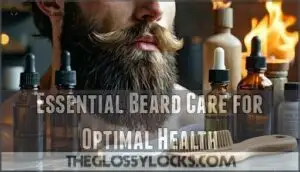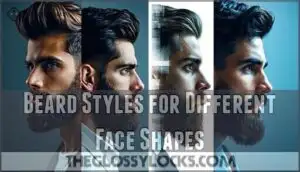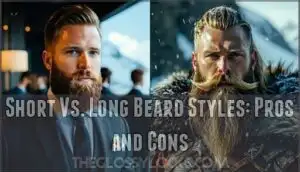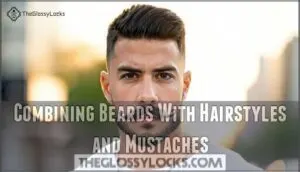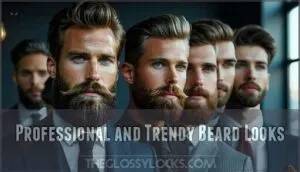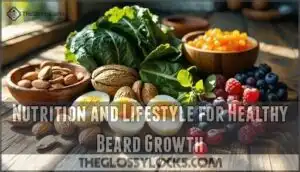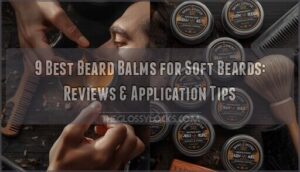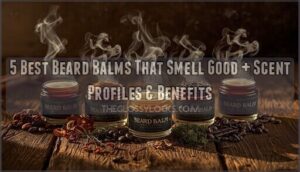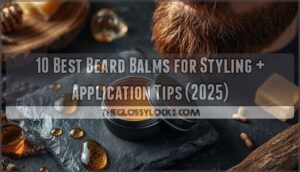This site is supported by our readers. We may earn a commission, at no cost to you, if you purchase through links.
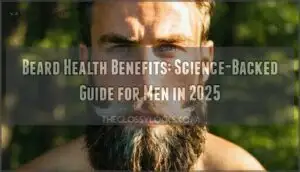
Research shows bearded men are consistently rated as more mature, trustworthy, and attractive, translating to real advantages in both professional settings and personal relationships.
Whether you’re growing your first beard or maintaining a well-established one, understanding these science-backed benefits can transform how you approach facial hair care and help you fully realize the health advantages hiding in plain sight on your face.
Table Of Contents
Key Takeaways
- Your beard blocks up to 95% of UV rays depending on thickness, significantly reducing skin cancer risk while eliminating the daily trauma and inflammation that razors cause to sensitive facial skin.
- Research consistently shows bearded men are perceived as more mature, trustworthy, and attractive, giving you real advantages in professional settings, social interactions, and dating scenarios.
- Facial hair acts as a natural air filter that traps up to 50% of allergens like pollen before they reach your airways, reducing respiratory irritation and potentially lowering asthma risk in dust-prone environments.
- Proper beard care—including washing 2-3 times weekly, daily oil application, and nutrient-rich diets with biotin, omega-3s, and protein—transforms facial hair from a style choice into a health asset that protects skin and boosts confidence.
Key Health Benefits of Growing a Beard
You might think a beard is just a style choice, but it actually offers real health advantages backed by clinical research. From protecting your skin to filtering the air you breathe, facial hair does more than just look good.
Here’s what the science says about growing and maintaining a healthy beard.
Natural UV Protection and Skin Cancer Prevention
While UV rays from sun damage can sneak through your defenses, a fuller beard acts like built-in skin protection. Here’s what beard density matters for cancer risk reduction:
- Beard UPF factors range from 2 to 21, blocking 50% to 95% of harmful UV rays depending on thickness and length.
- Longer beards over 1.5 inches provide near-maximal filtration, greatly lowering skin cancer risk in covered areas.
- Natural oil benefits extend protection—beard oils with raspberry or carrot seed oil add mild UV-blocking properties.
- Dermatologist recommendations still include sunscreen beneath beards, since coverage can be uneven and angles reduce effectiveness.
To combat this, consider using beard oil regularly to maintain moisture.
Reduction in Skin Irritation and Inflammation
Beyond shielding you from UV damage, your beard does double duty by actually preventing the daily trauma that razors inflict on your skin. Shaving irritation, folliculitis reduction, and eczema relief become real possibilities when you stop scraping blades across your face.
This break from skin microtrauma allows inflammation to settle down, giving you healthier skin underneath. Men with sensitive skin conditions often notice their beard health benefits include fewer flare-ups and improved comfort.
Respiratory Health and Allergen Filtration
Your beard also works as a natural air filter, trapping allergens before they reach your airways. Studies show facial hair can capture up to 50% of pollen particles, reducing respiratory irritation and allergy symptoms during high-pollen seasons.
Your beard traps up to 50% of pollen particles, acting as a natural air filter that reduces allergy symptoms
This allergen filtration creates immune defense benefits over time, potentially lowering asthma risk in dust-prone environments. Beards can even help filter out common allergens like ragweed.
Just remember that mask effectiveness drops with longer beards, so proper grooming aids both beard health benefits and respiratory protection when needed.
Beard Benefits for Sensitive Skin and Eczema
If you’ve got sensitive skin or eczema, letting your beard grow might actually calm things down instead of making them worse. Shaving causes repeated microtrauma that triggers eczema flares and skin irritation.
Your beard acts as a protective barrier for facial skin, reducing exposure to environmental irritants.
The key is gentle cleansing with soothing ingredients and proper hydration to prevent beard itchiness while supporting overall skin health.
Psychological and Social Advantages of Beards
Beyond the physical benefits, your beard can actually reshape how you see yourself and how others see you. Research shows that facial hair influences everything from your confidence levels to how people judge your character.
Let’s look at the science behind the psychological and social perks of growing a beard.
Boosted Self-Esteem and Confidence
Growing a beard isn’t just about looking good—it’s about feeling good from the inside out. Clinical observations show that beard wearers report increased self-esteem and reduced anxiety after growing facial hair.
This confidence boost factors into personal empowerment and masculinity, especially when your grooming tips align with your face shape.
You’re joining a beard community support network that celebrates healthy lifestyle choices and psychological well-being through men’s grooming.
Perceptions of Maturity, Trustworthiness, and Attractiveness
Your perception in social settings shifts when you grow a beard—studies show bearded men are consistently rated as more mature, trustworthy, and attractive. Across cultures, 62–68% of people associate facial hair with wisdom and life experience, while light stubble maximizes attractiveness ratings.
Full beards signal masculinity and status, amplifying dominance impressions and strengthening your social presence. These trustworthiness cues and attractiveness standards work together, making beard styles powerful tools for status signaling in men’s health and personal development.
Beards and Professional or Social Success
Your beard isn’t just making a style statement—it’s actively reshaping how colleagues, clients, and potential employers evaluate your competence and leadership potential. Research shows that professional beards improve career advancement opportunities, with corporate beard styles linked to perceived authority.
Women consistently rate bearded men higher in dating success surveys, while men report confidence boosts in social interactions. Your facial hair becomes a strategic asset in men’s fashion and workplace dynamics.
Personal Expression and Identity
Beyond professional perception and dating dynamics, your beard represents something deeper—a canvas for self-discovery where 68% of men report finding authentic confidence through intentional grooming choices that mirror their evolving identity.
Whether you’re exploring cultural beard norms or diving into beard subcultures, your men’s facial hair styles become powerful beard symbolism. This identity exploration through men’s fashion lets you craft a men’s look that genuinely reflects who you are, making beard self-image an authentic extension of your personality rather than just another men’s style trend.
Essential Beard Care for Optimal Health
Growing a healthy beard isn’t just about letting it grow wild—it’s about giving it the care it needs to thrive. Regular maintenance keeps your beard looking sharp while protecting the skin underneath from irritation and dryness.
Here’s what you need to know to keep your facial hair in top condition.
Importance of Regular Trimming and Shaping
Think of trimming your beard like pruning a garden—without regular maintenance, even the healthiest growth can turn wild and unkempt. Regular beard trimming keeps split ends at bay and maintains symmetry, which is key for a polished, professional appearance.
You’ll notice sharper definition along your cheeklines and neckline, transforming scruff into intentional style refinement.
Consistent beard shaping and grooming help you master beard maintenance, ensuring your facial hair always looks deliberate and well-kept.
Beard Washing and Conditioning (e.g., Bluebeards Original Mint Beard Wash)
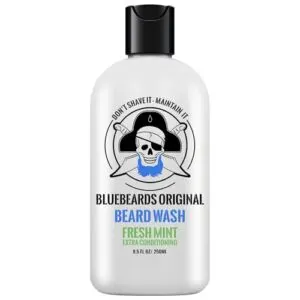
Just like your skin, your beard needs the right cleansing routine to stay healthy—and regular soap won’t cut it. Dedicated beard shampoo and conditioner preserve natural oils while removing dirt and preventing flakiness. Products like Bluebeards Original Mint Beard Wash offer natural ingredients—peppermint oil, menthol, amino acids—that cleanse without stripping moisture.
Key beard washing practices:
- Wash frequency: 2-3 times weekly prevents over-drying while controlling buildup
- Application techniques: Massage cleanser into damp beard, reaching the skin underneath
- Ingredient benefits: Natural formulas reduce itchiness by 47% and strengthen follicles
Using Beard Oil and Balm for Hydration
Once your beard is clean, hydration becomes your next defense against dryness, flaking, and that scratchy irritation nobody wants. Beard oil delivers moisture through natural oil ingredients like jojoba and argan, reaching both hair and skin underneath. Beard balm adds hold while sealing in hydration.
Apply daily—warm a few drops between your palms, massage thoroughly from root to tip. Regular beard moisturization reduces dandruff by 47% and keeps your facial hair soft and healthy.
Tools and Techniques for Effective Grooming
Good hydration won’t matter much if you’re using dull blades or skipping the right comb—your grooming toolkit directly impacts how healthy and sharp your beard looks. Invest in quality beard shaping tools and master proper beard grooming techniques for consistent results:
- Sharp beard grooming scissors for precise trimming techniques
- Beard-specific combs for detangling and shaping methods
- Quality trimmers for even beard maintenance
- Boar bristle brushes for distributing beard care products
- Styling tools like heated brushes for sophisticated product application
Your technique matters just as much as your tools—trim slowly, follow your face’s natural contours, and you’ll maintain that polished look.
Choosing The Best Beard Style for Your Face
Your beard isn’t just about health benefits—it’s also a key part of how you present yourself to the world. The right style can complement your natural features, boost your confidence, and fit seamlessly into your lifestyle.
Here’s how to match your beard to your face shape, personal style, and the look you want to achieve.
Beard Styles for Different Face Shapes
Your face shape isn’t just something you see in the mirror—it’s your blueprint for finding a beard style that actually works with your natural features instead of fighting against them.
Round face beards work best when you keep sides short and add length below the chin. Square face shapes shine with more chin hair and less bulk on the neck. Oblong beard styles need balance—don’t go too long. Heart-shaped beards benefit from width at the chin, like a goatee.
Oval face styles? You’ve got the golden ticket—most beard and face shape combinations work beautifully for you.
Short Vs. Long Beard Styles: Pros and Cons
Choosing between a short and long beard isn’t just about length—it’s about matching your lifestyle, maintenance commitment, and professional environment to what you can realistically maintain. Short beard styles like the 5 o’clock shadow or corporate beard need less daily effort but require frequent trimming. Long beard styles demand dedicated beard grooming and care—daily oil application, regular conditioning, and strategic shaping to complement your face shape.
- Maintenance needs: Short beards take five minutes daily; long beards need 15-20 minutes
- Styling options: Longer beards offer creative freedom with balms and shaping techniques
- Professionalism perception: Corporate settings often favor neat, short styles under three inches
- Seasonal suitability: Summer heat makes shorter beards more comfortable; winter cold favors length
- Face shape compatibility: Oblong faces benefit from shorter styles; round faces need length for balance
Combining Beards With Hairstyles and Mustaches
The right hairstyle and mustache combo can turn your beard from a simple facial hair statement into a complete look that showcases your personal style and highlights your strongest features.
Classic haircut pairings work best—try short hair and beard combinations with beard fades for a sharp, balanced aesthetic, or embrace long hair and beard styles for a bolder vibe.
Mustache styles like the chevron or Van Dyke add dimension to men’s facial hair styles, especially when you maintain proper length balance between your hair, beard, and mustache styles.
Professional and Trendy Beard Looks
Balancing professionalism with modern style isn’t always easy, but certain beard looks consistently deliver that polished-yet-approachable edge in 2025’s workplace and social settings.
The corporate beard remains your go-to for professional beard grooming—keep it 2-3 inches, well-shaped to complement your face shape, and maintained with quality styling products.
Trendy variations like the short boxed beard offer men’s style versatility, blending men’s grooming standards with trendy men’s hairstyles for that confidence-boosting edge in beard grooming routines.
Nutrition and Lifestyle for Healthy Beard Growth
Your beard’s appearance and growth potential aren’t just about genetics—what you eat and how you live play a bigger role than most men realize. From the vitamins on your plate to the habits you practice daily, small changes can transform your facial hair from patchy to powerful.
Here’s what actually works to support healthy, strong beard growth from the inside out.
Diet and Vitamins That Support Beard Health
Think of your beard as a garden—it needs the right nutrients to flourish. Feeding your follicles with a healthy beard diet ensures stronger, thicker growth from the inside out.
- Protein for Keratin: Eggs, chicken, Greek yogurt, lentils, and tofu supply amino acids essential for beard structure and prevent patchy development.
- Biotin and Follicles: Vitamin B7 from nuts and dairy strengthens strands, while niacin boosts blood flow to nourish roots.
- Omega-3 Benefits: Salmon, walnuts, and chia seeds reduce inflammation, improve thickness, and extend growth phases.
- Vitamin D Support: Salmon and fortified dairy activate dormant follicles, while zinc, iron, Vitamin A, Vitamin C, and Vitamin E maintain resilience and hormone balance.
Beard Growth Nutrients work synergistically—deficiencies slow progress and weaken hair.
Supplements for Beard Thickness and Growth
When diet alone doesn’t bridge the gap, targeted supplements can accelerate beard thickness and fill in stubborn patches—but only if you choose the right ones backed by clinical evidence.
Biotin Benefits include stronger keratin synthesis at 2.5–5mg daily, while Zinc Dosage of 11mg promotes testosterone conversion to DHT for facial hair growth. Collagen Peptides improve strand resilience, and Vitamin D activates dormant follicles.
Though not DHT Blockers, these work as a natural Minoxidil Alternative for healthier hair growth.
Skin Care Practices to Prevent Beard Dandruff and Itchiness
Beard dandruff and itchiness aren’t just annoying—they’re signs your skin’s moisture barrier is breaking down under all that facial hair. Combat these facial skin conditions with hydrating cleansers or antifungal shampoo for stubborn flakes.
Add exfoliation methods like gentle brushing twice weekly to lift dead cells, then apply anti-inflammatory agents such as tea tree oil.
Always do patch testing before trying new skincare products—your beard deserves the same care as your face.
Healthy Habits for Stimulating Facial Hair Growth
Your beard’s growth potential lives or dies by what happens outside your grooming routine—sleep, stress, and circulation make or break those follicles before you ever pick up a trimmer. Try these healthy lifestyle habits for beard growth:
- Sleep quality directly affects DHT levels and facial hair growth—aim for 7-9 hours nightly
- Exercise benefits include improved circulation to deliver nutrients for facial hair growth stimulation
- Stress reduction lowers cortisol that blocks beard growth at the follicle level
- Hydration importance can’t be overstated—water aids skin care for beard growth from within
Frequently Asked Questions (FAQs)
Can beards trap harmful bacteria or germs?
Surprisingly, research shows that beards don’t harbor more harmful bacteria than clean-shaven skin. Your beard microbiome contains natural protective bacteria that may actually reduce infection risk.
However, proper hygiene practices like regular beard sanitization through washing remain essential for maintaining healthy skin and hair health beneath your facial hair.
Do beards affect facial temperature regulation?
Facial hair acts as natural insulation, trapping warm air near your skin during cold weather while reducing heat loss.
However, beards can limit sweat evaporation and airflow in hot climates, potentially making you feel warmer—though beard length and density affect this cooling effect considerably.
How does beard growth change with age?
Ironically, as men age and finally master beard care, hormonal changes slow the beard growth process. Testosterone levels decline, reducing growth rate in beard follicles.
The graying process accelerates, patchiness factors increase, and maintenance needs shift for facial hair growth.
Can beards help with acne prevention?
Reduced shaving is the main way beards help with acne prevention. Every time you shave, you create tiny cuts that invite bacteria and inflammation—leading to folliculitis, acne keloidalis, and breakouts. Growing a beard eliminates this repeated trauma, giving your skin a chance to heal naturally.
Do beards impact romantic relationship perceptions?
Studies show men sporting facial hair are seen as better partners and protectors. Moderately full beards boost perceived masculinity and attractiveness in mate selection, with women rating bearded faces as more invested and trustworthy in relationship dynamics and partner preferences.
Conclusion
Take Marcus, a 34-year-old office manager who ditched his razor two years ago—he’s since dodged three dermatologist visits for razor burn and gained what colleagues describe as "executive presence."
Your beard isn’t just facial fuzz; it’s working overtime to protect your skin, filter irritants, and signal confidence to everyone you meet. The beard health benefits and importance extend far beyond appearance, touching everything from UV defense to professional perception.
Now that you understand the science, your grooming routine becomes more than maintenance—it’s an investment in protection, presence, and long-term skin health that pays dividends daily.
- https://pubmed.ncbi.nlm.nih.gov/22090417/
- https://www.nwface.com/beards-block-the-sun-keep-skin-young/
- https://www.piedmont.org/living-real-change/are-there-health-benefits-to-having-a-beard
- https://journalmsr.com/bearded-surgeons-friend-or-foe-in-the-fight-against-surgical-site-infections-an-updated-and-comprehensive-literature-review/
- https://fivestarbarberbrand.com/2025/08/02/the-health-benefits-of-growing-a-beard/


